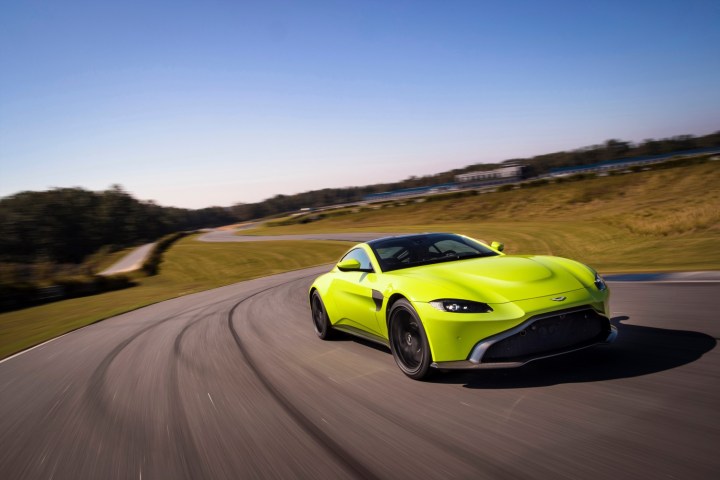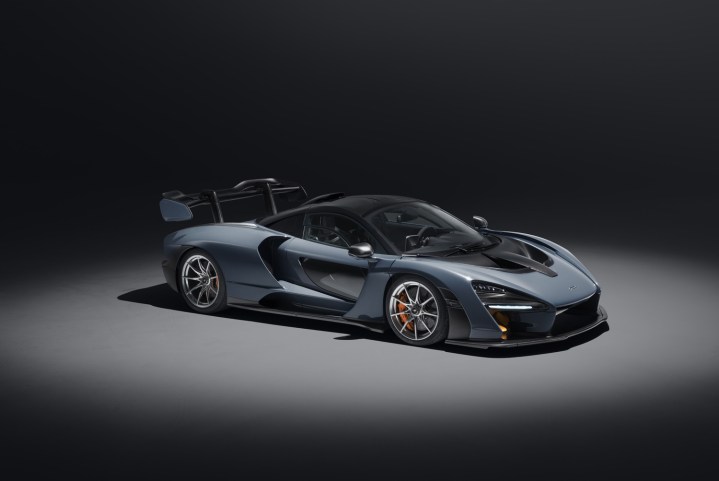Carmakers from all over the automotive spectrum will need to spend billions on developing electrified and autonomous technologies during the 2020s. Even the companies that are doing relatively well are forming alliances with other firms (including rivals) to share the burden, meaning the automotive industry is more tangled than it’s ever been. Our guide allows you to navigate the latticework of mergers, acquisitions, and tie-ups.
Aston Martin

Aston Martin used to be part of Ford, along with Volvo and Jaguar. Today, it’s an independent company with a long list of shareholders and investors that include Mercedes-Benz parent company Daimler and a London-based investment firm named Investindustrial. The tie-up with Mercedes gave Aston Martin access to AMG engines for its latest sports cars. The company has struggled since going public in 2018, and it was rescued by Canadian billionaire Lawrence Stroll in 2020. The new management’s plan is to turn Aston into a British Ferrari.
BMW

BMW (Bayerische Motoren Werke) was founded in 1916 to manufacture aircraft engines. It quickly branched out into the motorcycle sector and it released its first car, an Austin Seven manufactured under license, in 1928.
In 2020, BMW operates its namesake brand, an innovation-focused sub-brand named “i”, a go-fast division called M, Mini, and Rolls-Royce. It works closely with tuner Alpina, though it doesn’t own any of it, and it agreed to provide electric motors to Jaguar -Land Rover. Many smaller manufactures (like England-based Morgan) use its engines.
Daimler
The original Daimler-Benz was founded in Germany in 1926. The corporation in its current iteration — known as Daimler AG — was founded in 1998. Daimler owns Mercedes-Benz, Mercedes-AMG, Mercedes-Maybach, Smart, and several heavy truck companies including Freightliner and Western Star. It launched a sub-brand named EQ that focuses on electric, hybrid, and plug-in hybrid cars, like the battery-powered EQC. Additional models (including an EQA and an EQS) will join the range during the 2020s.
Daimler has several shareholders. Chinese investor and entrepreneur Li Shufu owns nearly 10% of the group through an investment firm, and Geely (the automaker Shufu founded) purchased half of Smart in 2019. Another Chinese company named Beijing Automotive Group, which is owned by the Beijing government, holds a 5% stake, and Kuwait’s Sovereign Savings Fund has 6.8% of the group.
Fiat

Here’s a little known fact: The name Fiat is an acronym. Fabbrica Italiana Automobili Torino was founded in 1899, meaning it’s one of the oldest automakers in the world. Originally, Fiat mainly produced railroad engines, tractors, and airplane engines. By the 1950s, it offered a full lineup of cars ranging from tiny economy models to sporty convertibles. Fiat acquired Chrysler after the brand filed for Chapter 11 bankruptcy in 2009.
Today, Fiat-Chrysler Automobiles (FCA) controls Abarth, Alfa Romeo, Fiat, Fiat Professional, Lancia, Maserati, and all of Chrysler’s brands including Dodge, Jeep, and Ram. That’s right, the fire-breathing Hellcat and the pint-sized 500 live under the same roof. FCA began searching for another automaker to merge with in the early 2010s, and it very nearly joined forces with Renault but the deal fell through. It’s now in the process of forging an alliance with Paris-based PSA Group, which owns Peugeot, Citroen, DS, Opel, and Vauxhall. The merger will be complete by early 2021.
Ferrari

Enzo Ferrari founded the company that bears his name in 1947, though he began racing decades before he built his own cars. Fiat worked with Ferrari on a sports car named Dino during the 1960s, and the Turin-based giant bought a 50% stake in its smaller partner in 1969. It upped its share to 90% after Ferrari died in 1988.
Ferrari stood out as Fiat’s crown jewel until executives finally decided to let it fly with its own wings. The Prancing Horse split from its parent company in January 2016. The newly independent brand held an initial public offering (IPO) shortly after, and it’s more successful than it has ever been.
Ford
Ford is the company that famously democratized the use of assembly lines for cars. The Model T is widely considered the first massively available automobile. At one point in time, Ford owned or had major stakes in Volvo, Jaguar, Land Rover, Mazda, Mercury, and Aston Martin. All of these brands were either sold or shut down, and today the Blue Oval’s only fully-owned brand is Lincoln.
Ford formed a partnership with Volkswagen in 2019 to develop commercial vehicles, autonomous technology, and electric cars. It also invested $500 million into electric truck startup Rivian, though what the project will spawn hasn’t been made public yet.
General Motors

General Motors downsized considerably after filing for bankruptcy in 2009. It pared down its portfolio to Buick, Cadillac, Chevrolet, GMC, and Holden, a brand distributed exclusively in Australia that’s set to disappear soon. While GM is best known for staple models like the Chevrolet Corvette, the company was also responsible for creating the mobility systems on the lunar rovers used on the Apollo 15, 16, and 17 missions.
Honda

While most of the major automakers entered the industry before or during the early 20th century, Honda wasn’t founded until 1948, making it a relatively new kid on the block. Honda’s name comes from Soichiro Honda, one of the company founders. Honda also owns Acura. In addition to cars, it makes a long list of products including motorcycles, ATVs, scooters, lawnmowers, outboard motors for boats, and even airplanes.
Hyundai

Hyundai, based in South Korea, released its first car in cooperation with Ford in 1968. Today, Hyundai Motor Company partly owns Kia, one of its chief competitors. As they say: If you can’t beat ’em … make yourself at least partially represented among their shareholders. The two automakers share numerous parts including engines and transmissions. In 2015, Hyundai announced a new luxury sub-brand called Genesis. And, in 2019, Hyundai and Kia jointly invested about $90 million into Croatian electric car startup Rimac. The partnership will spawn an electric hot hatch.
Mazda

Japan-based Mazda was founded in 1920 to manufacture cork products. It introduced a three-wheeled, motorcycle-based pickup named Mazda-Go in 1931 and launched its first car, the R360, in 1960. Ford owned about a third of Mazda in the 1990s but it divested its shares when it downsized and the firm has been independent since. It regularly collaborates with partners across the automotive spectrum, however. It manufactures Fiat’s 124 Spider roadster, and it’s working with Toyota to build a factory in Huntsville, Alabama, that will make crossovers.
McLaren

McLaren Automotive is part of the McLaren Technology Group. In addition to building fast, sexy sports cars, the British firm runs the McLaren Formula One team and a division named Applied Technologies that makes a dizzying selection of products including bicycles, bobsleds, medicine, and even solar panels. Bahrain’s Mumtalakat sovereign wealth fund owns 56.4% of McLaren.
Mitsubishi

The Mitsubishi Corporation is Japan’s largest “general trading company.” The carmaker started in 1970, after breaking off from Mitsubishi Heavy Industries. Mitsubishi remained independent for a long time, but it is now controlled by the Renault-Nissan Alliance.
Renault-Nissan

Renault owns a 43% stake in Nissan, while Nissan controls just 15% of Renault. Nissan also runs Infiniti, its luxury-focused division, and it recently revived the Datsun brand to sell economy cars in emerging markets. Renault also owns Romanian car-maker Dacia, and it holds controlling stakes in both AvtoVAZ (one of Russia’s largest car companies) and Mitsubishi. Renault left the American market in the 1980s, and it’s not planning on coming back anytime soon.
Saab

Saab was founded by Svenska Aeroplan, a company which operates in the aerospace and defense sectors. National Electric Vehicle Sweden (NEVS) purchased Saab’s assets after the company filed for bankruptcy, and it hoped to turn the 9-3 sedan into an electric car, but its plans are seemingly stuck in neutral. What’s next is anyone’s guess.
What’s certain is any and all future cars built in Saab’s factory will not wear its name. NEVS lost the rights to the name and to the brand’s emblematic griffin logo. So, while Saab isn’t officially dead, it’s in a vegetative state, and it’s kept alive only by the folks who tirelessly cherish its illustrious heritage.
Subaru

Subaru is on a roll these days. It set new annual sales records for 10 consecutive years, and its success is even more impressive when you consider it remains an independent company, though Toyota owns a 16% stake in it. The two partners notably co-produce the 86/BRZ twins, and the Crosstrek Hybrid uses Toyota-sourced technology. Looking ahead, Toyota and Subaru plan to co-develop an electric crossover tentatively due out halfway through the 2020s.
Tata

Indian company Tata’s claim to fame was releasing the Nano, which cost $2,500 and often caught fire, in 2009. It dabbles in the luxury segment, too. It purchased Jaguar and Land Rover in 2008 and has rejuvenated both brands without diluting what they both stand for: British luxury. Rumors of an imminent sale often make headlines, neither company is doing particularly well, but Tata maintains it wants to hold on to them in the foreseeable future.
Tesla

A team of engineers in Silicon Valley founded the electric car company Tesla in 2003. Currently, the company’s vehicles are manufactured in Fremont, California, at the former New United Motor Manufacturing Inc. automotive facility. Its lineup includes the Model S, the Model X, the Model 3, and the Model Y. The company recently outlined plans for a semi-truck, the infamous Cybertruck, and a successor to the original Roadster. It also hinted it could ask a team of Chinese engineers and designers to develop an entry-level city car.
Toyota

Toyota is one of the largest automobile manufacturers in the world. It owns Daihatsu, Lexus, and Hino Motors. Toyota was also behind Scion, the youth-focused brand that sold economy cars like the toaster-shaped xB. It shuttered the division in 2016 due to slow sales, though, and hasn’t looked back since.
Volkswagen

Volkswagen — a name that means “people’s car” in German — rose to prominence by selling the humble, rear-engined Beetle all around the world. Today, it’s one of the largest automakers in the world. Its impressive portfolio includes its namesake brand plus Audi, Bentley, Porsche, Bugatti, Lamborghini, SEAT, Skoda, MAN Trucks, Scania, and Ducati.
The Volkswagen Group embarked on an immense electric car offensive when it released a Golf-sized hatchback named ID.3 for the European market. It’s not coming to the United States, but we’ll get a battery-powered crossover called ID.4. We can also look forward to a retro-inspired van previewed by the ID Buzz concept. We’re still crossing our fingers that the head-turningly awesome ID Buggy concept we drove in California will reach production.
Volvo

Volvo is a Swedish company founded in 1927 then bought by Ford in 1999. Since 2010, its new owners, Zhejiang Geely Holding Group in China, have invested a substantial amount of time and money into updating its lineup, focusing on electrification and autonomy. Today, Volvo stands out as one of the market leaders when it comes to technology.
Geely and Volvo co-founded Polestar, an upmarket brand that specializes in luxurious electric cars.
Innovation is the future for the automotive industry. Leading car manufacturers are in a technological race to produce the next great modernization. The first to an electronically controlled differential—Mitsubishi. The first to create the now-ubiquitous SmartKey—Mercedes-Benz. The first to turbocharged engines—let’s just say that was an epic battle between GM and Ford. Some German car manufacturers are even predicting that we’ll replace halogen and LED headlamps with lasers soon.
With all the competition, you might be surprised at how many manufacturers have become partners. But partnerships are a great way to compete – automakers find allies with new tech and features that can combine to increase their selling power. These alliances push innovation to new levels, so we’re not going to complain when it gets a little confusing from time to time. Bring us the lasers.





